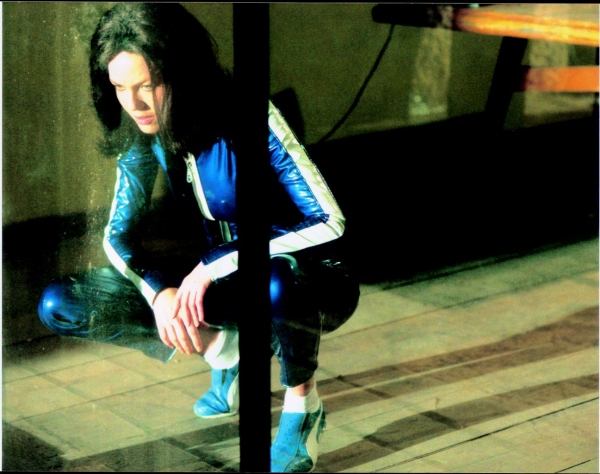Decoding a Digi-Demon
New media has relentlessly dug its cyber-claws into the heart of cinema for over 20 years now, constantly raising the bar in an industry of simulacra manipulation that seems to be entirely without limits. For many, Spielberg’s dinos and Jackson’s Gollum are revelatory manifestations of the imagination made possible by the benevolent hand of new media’s godliest offspring, CGI. For others, however, those creations of the digi-divine consistently raise frightening questions about the ever-warping nature of human perception. Peruse the shelves at your local bookstore and you’ll find Jean Baudrillard flanked by a host of media theorists eager to remind us that 1) the future is pixelated, and 2) we won’t be able to tell. According to Olivier Assayas, however, the future is now and the blurring has begun.
It is while drugging the beverage of her work-rival Karen (Dominique Reymond) in the bathroom of an airplane not five minutes into the film that Connie Nielsen’s Diane and Assayas’s demonlover seem most lucid. She has an objective, we have a familiar scene of sabotage, Karen drinks, and everyone waits to see what happens. It’s simple, and—though we know little of their relationship—as clear-cut as the film will ever be. Spilling into the terminal, the designer-dud business troupe discuss the panoply of drugs available to remedy their flight-induced insomnia as if there has never been another option. Karen puts in her two cents, begins to feel unwell, exits to her jet-black Audi and is quietly swept into the trunk by two men waiting in the wings. No more Karen, new business card for Diane.
It’s in these first moments that Assayas delineates demonlover’s all-too-familiar environment: a self-medicated world in which the ubiquity of prescription drugs is outmatched only by the number of cover stories glamorizing their use; a place where happy, sad, and the middle states of consciousness are a mere pill-pop away, where psychological perception of emotion, the self, of the quotation-bound “real” is constantly being muddled at our own hands because, apparently, we just won’t have it any other way. This intrinsic urge to blur borders, to deceive and distort, not only becomes demonlover’s ideological leitmotif, but a disorienting structural device for narrative and editing practices that leave the audience as dubiously ill-informed as the film’s floundering heroine.
A cut from candy-colored manga characters to their similarly kaleidoscopic real-life lip-synching club sisters, serves as a frightening segue to the heart of an issue subtly elicited in the preceding shot-reverse shot between ice-cold Diane and her vampy computer generated doppelgänger: Is the organic moving towards artificiality, or vice versa, and should we be more scared of a rise of the machines, or the mechanization of ourselves? Assayas’s take—contrary to sci-fi history—seems more interested in the latter, the dehumanization of a race increasingly unconcerned with the preservation of its inherent human capacities. It sounds silly at first, almost premature. But if demonlover is the future of cinema, it’s a masterwork of today, reminding us that we’ve just merely merged onto the new media highway, and that it ramifies far beyond the instant message. Demonlover’s live sex is as stunted as the deteriorating verbal communication; watching all modes of intercourse give way to their simulated brethren is not so frightening in reality as it is the hands of a visionary like Assayas. A cross-continental, multilingual, demi-digital work of limina with roots only in its harsh critique of the world within which its characters “exist,” demonlover ingeniously suggests why email is a horrific substitute for the human contact we all take for granted, free of soothing technology’s protective sugarcoating, “Well, it makes life easier...”
A short coda returns the film to sobriety in another familiar environment: suburban America. An adolescent boy swipes his father’s credit card to log into the interactive S&M website Hellfire Club. Once an international corporate power player dealing 1’s and 0’s, Diane is now nothing more than a choose-your-own-torture fantasy girl at the mercy of a middle schooler. But with all the censorable material demonlover unabashedly delights in splashing onscreen, the most chilling images Assayas offers are in a final camera move past the boy to his computer monitor. Ending his dark treatise on the world not with, but of new media, he glides past the student and his biology homework to rest on digital-Diane. For an eternal moment, she is staring quite blankly, at us. —MP

Language Barriers
“Does this turn you on?” On the surface this titillating question, posed by corporate spy Connie Nielsen to a rival, refers to the illicit website coveted by the ruthless characters of Olivier Assayas’s demonlover, but it could also be posited by Assayas himself to his audience. Demonlover delivers all of the “reliable” Euro-indie art-house movie conventions certain to arouse a specific audience subset, yet the movie is not wholly the sum total of its parts. In demonlover, an appealing surface veneer masks the more complex, and often unsettling core. Intriguingly, a number of the actors in this French film, like Nielsen and Chloë Sevigny, do not speak French as their first language, yet the script calls upon them to be convincing savvy international businesswomen. The fluidity of language in this urban setting creates another masking layer in the film’s narrative. As a thriller plot point, it makes sense that an assassin and spy could adopt any pertinent language, whether it be English, French, or Japanese, at a moment’s notice. Yet Assayas’s comfort in directing dialogue not in his first language draws attention to his choice to set the primary action in France. Somehow, the scenes where Sevigny barks out her annoyance at her ice queen boss in French has more gravitas, more mystique, and more tension than when she lapses into her crudely natural East Coast American accent. Assayas understands this crucial difference (angry blonde in heels speaking French = erotic) and in utilizing it, plays with our preconceptions regarding “sexy” art films. Hearing American, Danish, or Japanese actors speaking in French only intensifies the perceived European art film-ness of demonlover and language in this film becomes another signifier of arousal. However the most unsettling question posed by demonlover is not whether these scenarios turn us on, but rather if in being aroused we’re then implicated in a responsibility for their perpetuation. If you find torture porn exploitative, then does consuming it, even in a detached narrative setting, make you slightly culpable for its continued creation? The final images needle the viewer for at least the beginning of an answer. —KW

Blind Ambition
I suppose Alfred Hitchcock makes for an easy scapegoat. Surely, his role in the creation of the ice queen archetype that plagues so many of our contemporary cinematic portraits of career women (all striving for control in a patriarchal society before smacking into the realization that—surprise!—they really just want to be dominated) is clearly on reverential display in Assayas’s demonlover. Unless we can consider inflicting this dangerous social branding on a brunette rather than a blonde “progressive,” the images of corporate femininity that pop up in demonlover are nothing if not shocking in their absolute predictability.
There’s Diane, the cover girl corporate climber (Connie Nielsen); Elise, the secretive secretary (Chloë Sevigny); Elaine, the demanding diva (Gina Gershon); Karen, the aging executive being tossed for a newer model (Dominique Reymond). Assayas employs them all, with only minor intellectual upgrades to their simplistic molds. Rather than reflecting on the impossible contradictions placed upon these women’s heads (as each copes with the emotions=weakness brand of math that keeps the glass ceiling windexed while still maintaining their inherent femininity), demonlover instead wields its women as capitalist weapons devoid of any real ammunition, not unlike the pornographic representations the titular contract is trying to spread on a global scale.
The story, which delves into the porntastic realm of manga anime (itself a star pupil in the “take it and like it” rape fantasy school of thought) and the prevalence of masculine wish fulfillment on the net, is the sort that feels the need to follow hints of lesbianism with curative hetero kisses, thereby oddly debunking the very cultural taboos it strives to bring to light. Moreover, by framing sexual violence not only as a tradable commodity, but one that can be calmly accepted and dealt with by women themselves (one perverse example: the sight of Diane coyly lighting up a cigarette after watching a manga in which a multitude of writhing cartoon Kewpie dolls are sexually assaulted by a many-pronged octo-penis), demonlover entices the spectator to associate with these women via cool dissociation. Instead of feeling suitably out of control along with Assayas’s feminine subjects, we are asked to back away to peep show distance and enjoy the proceedings with an emotional blank slate.
The rare scenarios that attempt to subvert this commentary on the socially perceived “submissive” nature of female sexuality (perfectly encapsulated in the image of Elise playing video games in the nude, ruthlessly blowing away army men with her electronic equivalent of a strap-on) amount to little more than titillation under the guise of protest. Diane, conversely, is afforded the right to inflict violence in reality—rather than toying around with virtual dominance fantasies—but with damning results. Though she does literally plug her lover/rapist/co-worker pre-orgasm, the end result of her momentary triumph is to be reduced to a sexual pawn for American teenagers wielding Daddy’s credit card. Diane is consequently demonized one degree further, and the audience is implicated in her fall through this alternately disturbing and dull rabbit hole of sexual violence. Whether role-playing the dominatrix, the pliant conquest, or the sex slave, she is not once allowed to escape from the story’s condemnation of her seemingly offensive status as independent woman.
A girl-on-girl catfight, ironically enough, is the film’s only moment of gender transcendence, effectively desexualizing a trope that has become little more than a choreographed excuse for women to rip each other’s clothes off. Serving as narrative axis, the catfight does what the film as a whole cannot: infuse its female characters with strength beyond their own repressed sexual wiles, recodifying the femme fatale as a personne fatale, in all its sloppy reality. For a film that fetishizes violence to an infinite degree, the hair-pulling and throat-slashing is surprisingly obscured, then drenched in harsh lighting that diffuses the pleasurable response we have been conditioned to exude upon such a display. The overall effect is something akin to a wake-up call; ironically, it takes a moment of brutality to shock us back into awareness that these women are actually people and not mere playthings.
To grow rankled at demonlover’s portrayal of women is undoubtedly to be written off as political correctness, or, worse yet, prudishness. Yet, as film has proven time and again, misogyny (however mild) can still be sexy, De Palma being only one of the multitude of filmmakers who routinely toys with the archetypes that Assayas is employing to greater effect. To put it crudely, demonlover lacks anything resembling an orgasmic payoff that would justify such treatment of the female sex. Dissatisfied, one is simply left to light up a cigarette in hopes that the next go around might be more enjoyable. —SS

The New Flesh
In between demonlover’s frigid boardroom calculations and quietly cutthroat merger meetings, Diane (Connie Nielsen), supposed representative of the Paris-based conglomerate, The Volf Group, receives a massage in her hotel suite. Ostensibly a moment of relaxation to buffer the ruthless oneupsmanship that defines her (ultimately transitory) position within the company’s hierarchy, the massage seems not to soothe Diane’s body; rather, the pulling, stretching, and thumping of her back, arms, and legs appears more akin to the jackhammering of concrete. Her joints lightly crack, the muscles are yanked taut, her skin is rubbed raw—it’s an erasing of flesh. In Assayas’s nightmarishly contemporary world, flesh seems to be on its way out, victim to an emerging market in which everything is commodified, where sex and violence aren’t just accessible but easy to own. Loss of identity here segues into the digital realm—a sort of Persona for the age of media saturation.
Assayas’s landscape is one of accoutrements: water bottles, first-class airline bread baskets, ATMs, cell phones, credit card machines spewing receipts. Swathed in objects, demonlover’s players need not grapple with trivialities like moral value or soul-searching. Chloë Sevigny’s Elise is consistently upstaged by her designer blouses, while Gina Gershon’s terribly self-assured Elaine (her tight tee-shirts are ironic billboards, her zip-up ankle-high boots as deflective as steel armor) is only as confident as her fashion sense allows. Brand names take the place of skin—Diane pinpricks a drugged syringe into the foil cover of her competitor Karen’s single-serve Evian cup as if it were flesh. Techno-gadgets replace human interaction—when Chloë transfers the files from Karen’s palm pilot to her own, she’s sucking the very essence from her colleague, already incapacitated in the hospital. (Usually expertly contained, Charles Berling, shaven and bloated, seems to have an excess of flesh here. His Hervé, both lazy and predatory, the tortoise and the hare rolled into one, is all bulbous, protoplasmic lumps.)
As in all Assayas films, everything is tactile, as if you could brush your fingers across the screen and feel the trace of a cheek. Skin is a commodity itself, it can be bought, sold, and desecrated. Assayas doesn’t get as literal as Cronenberg (for me, Videodrome’s videotape-swallowing abdomen always seemed like a rather tacky device), and the film is all the more resonant for it. In their casually desperate ploys to claim a chunk of the multimedia pornography and violence industry, Diane, Hervé, and Elise end up as facsimiles of their former selves, slaves to its base supply and demand mentality. In a night-time car ride through a rainstorm, Assayas shoots through the splattered windshield. As the scene progresses, the raindrops appear to pop and dissolve on the actresses’ faces like pixels. The turning point in the film, it is here that we see the dissolution of flesh into something more alterable—the beginning of an inexorable downward spiral that will lead Diane to a new kind of hell on Earth, as a mere collection of digits on a 12-inch monitor. —MK

Basest Instinct
In 1996’s Irma Vep, Olivier Assayas speculated—under various levels of self-conscious displacement and fictionalized self-referentiality—about the possibility of a contemporary remake of the Louis Feuillade serial Les Vampires (1916). In demonlover he jettisons the pretense and goes ahead and does it. Lacking Griffith or Chaplin’s contemporaneous Victorian tendencies, Feuillade’s films are now remembered as the first unabashedly 20th century strain of cinema: urban, mysterious, paranoid, criminal, and indecipherable. Demonlover begins with that world of espionage, of double agents and drugged damsels, and brings it into the 21st century of media and global capitalism. Luckily, Assayas is interested in more than just updating the technology of this old story. Like Antonioni 40 years ago, he’s trying to diagnose the contemporary moral landscape, and he finds that far more than Eros is sick these days. Like Béla Tarr ten years ago, this vision is only expressible as the infernal—Damnation or Sátántangó. As is evident from the very title, demonlover is a film that takes place in Hell. The literal location of this Hell is an “interactive torture website” apparently originating from Mexico in which women dressed as comic book heroines are strapped to metal beds and electrocuted according to the whim of the site’s subscribers. But this is only the Ninth Level in a tour that begins, in the film’s opening scene, onboard the first-class cabin of a transcontinental flight, the luxury seats reclining into coffins, punctuated by frequent cutaways to the hellish explosions from whatever Hollywood or Hong Kong product is displayed on the plane’s monitors. The visitor to this inferno of cold corporate glass and steel is the no-less-damned character played by Connie Nielsen; sometimes called Diane de Monx, she is in fact without name or origins. Manipulated and abused like a von Trier innocent, she intends to do the same to others—that is if she can figure out what side anyone is really on, including herself. Her boss is called “Wolf,” but her colleague (Charles Berling) looks like one, eats like one, fucks like one. David Thomson once wrote that Monica Vitti’s beauty was a sign of her spirituality in her Antonioni films, but Nielsen’s here is a sign of her soullessness, each successive couture design sagging off her body like rotting flesh, until her final black latex jumpsuit brings us right back again to her progenitrix, Feuillade’s Musidora. “Back to the primitive!” grunts a song blasted from a TV set, but we’ve been there all along, in a falsely sophisticated world of intellectual property negotiations and high-tech gadgetry more savage and primitive than the 2001 apes’ battles for watering holes. —ES
